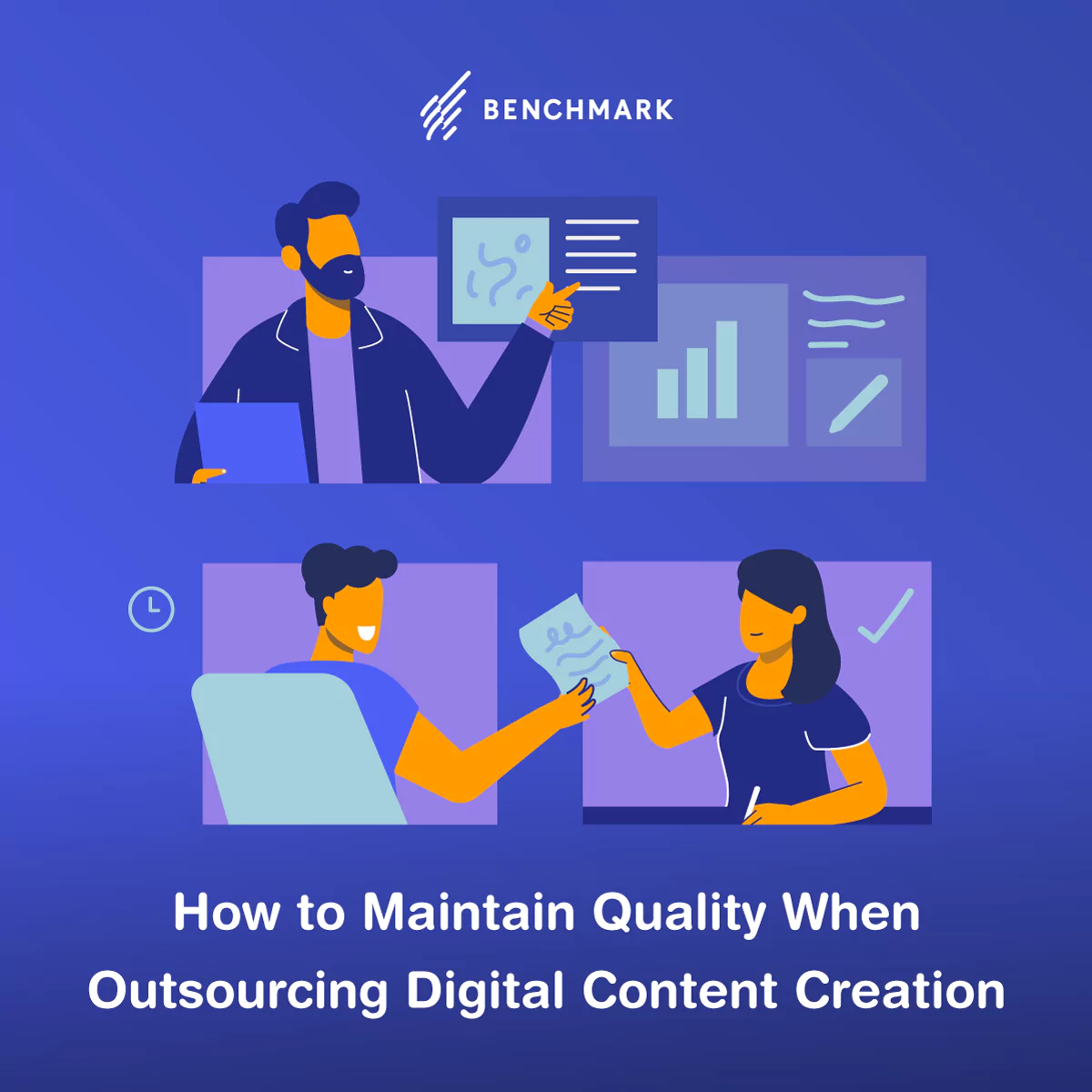How to Maintain Quality When Outsourcing Digital Content Creation
February 3, 2021 6 min read

One of the challenges organizations often encounter when they decide to outsource digital content creation is quality. It’s true that there are countless content mills that crank out low-quality articles at unbeatable prices, but you can find quality copy tailored to your voice and audience with the right approach to outsourcing.
Getting your money’s worth and publishing compelling content regularly isn’t a matter of getting lucky and finding the right writer. You can get quality content by establishing clear expectations and communicating your goals when you outsource.

The benefits of Outsourcing Written Content
Writing copy yourself or hiring an in-house writer gives you more control over the creative process, but outsourcing yields the following benefits:
- It saves you time. You will have more time for other important tasks.
- You can publish content more frequently. A regular publication schedule is essential for developing your online presence and keeping your audience engaged.
- It’s affordable and flexible compared to an in-house writing team or a traditional agency.
- You have access to a wide pool of talents with unique backgrounds.
- You can work with professionals who specialize in different types of content, like social media posts or whitepapers.
- You can get content that feels professional and meets your goals in terms of engagement and readability. Professional writers know how to create copy that makes people want to keep reading.
- You get access to an entire team of experts with skills like consulting, strategic planning, SEO, writing, or editing.
- It’s easy to scale up or down if you decide you want to publish at a different frequency.
In order to get these benefits, you will need to approach outsourcing as an investment and make quality one of your top priorities when choosing a content creation service.
How to Outsource Written Content Without Sacrificing Quality
Many organizations turn to outsourcing as a way of saving time. While you can eventually rely on a content creation service to deliver quality content with little involvement on your part, it’s best to adopt a hands-on approach at first.
The following steps will help you communicate, set clear expectations and provide writers with guidelines they can use to meet your quality standards.
Step #1: Identify Your Needs and Goals
When you outsource written content, knowing what your needs and goals are helps you communicate and establish clear requirements for the finished product:
- Identify your current needs, including how often you need to publish content, the writer’s qualifications, and the channels the content should be suitable for.
- Establish goals by defining the desired effect of the content. You can focus on generating leads, re-engaging existing customers, or increasing awareness for your brand. Think about how the voice and message can convey your values and help you become a thought leader in your industry.
Step #2: Decide on a Budget
How much can you afford to spend on outsourced content? What is your expected ROI?
You can budget for outsourced content by choosing an optimal price range per piece or a monthly rate for a specific number of pieces. You can also decide how much you’re willing to pay per word if you expect the content length to vary.
Step #3: Research Current Trends and Your Audience
Analyzing data from search fields and traffic on your website can give you valuable insights into what your audience wants to read about and what content format they prefer.
Keep content creation trends in mind when outsourcing. For example, marketers are currently prioritizing user-focused content that feels more personalized for each buying stage, and the content topics address specific issues.
Many organizations are also investing in Q&A formats to increase their chances of getting their content higher on search result pages, thanks to Google’s Featured Snippets.
Step #4: Choose the Right Content Creation Service
Make sure your content creation service is a good fit for your brand. Here are some areas to focus on when you research and compare options:
- Reviews and references can help you identify the services that deliver quality content consistently.
- Find out about the writers, how they are selected and what kind of background they have.
- Go over the service’s mission statement. Is there an emphasis on quality?
- Read the service agreement or contract carefully. Look for the service’s policy regarding customer satisfaction.
Step #5: Find Out More About Editing
When you outsource content creation, it’s essential to choose a service with a solid editing process. A good content creation service should have editors who proofread content, look for mistakes and work with writers to tweak content until it meets clients’ expectations.
Ask about the editing process and the quality standards that the editors have. Make sure you can request additional edits if needed.
Step #6: Develop a Style Guide
Creating a style guide ensures consistency and provides a clear point of reference regarding what your content says and how it says it.
It’s best to use an existing guide like the AP Style guide as a starting point. Writers will be familiar with it and will refer to it for details like capitalization and grammar.
Your style guide should include the following elements:
- Your formatting preferences. Be as specific as possible regarding sentence and paragraph length, spacing, indentation, font, headers, bullet points, bolded text, and more.
- Your brand’s tone and voice. Describe your brand’s personality and provide examples of the voice to emulate.
- How to address your audience. Indicate which person or point of view to use, whether to use rhetorical questions and how the content should make the reader feel.
- Things to avoid. Some words and expressions can convey a negative impression or feel too technical. You should also identify what competitors to avoid.
Step #7: Create Detailed Instructions
Professional writers know how to adapt quickly and meet a client’s expectations once they receive detailed instructions for an assignment. You can make the writer’s job easier by covering the following points in your instructions:
- A brief description of your target audience, including your preferred reading level, where readers are in their buying journey, and what their main pain points are. (This should be in your style guide, but it doesn’t hurt to repeat it here.)
- The goals you want to achieve with the piece of content, including the main takeaway.
- An outline or some key points you would like to include.
- Your SEO requirements, including keywords, density, and links.
After You Publish
You can build an outsourced content creation process that consistently gets better by monitoring how your content performs after publication. Use your findings to update your goals and instructions.
Industry experts say that the most important statistic to track how content performs against business objectives is the number of leads generated. However, there are additional key performance indicators you can track to get a more comprehensive picture:
- Unique page visits and time spent on a page.
- Inbound links.
- Shares, likes, and comments on social media.
- Downloads for whitepapers.
- The growth rates for data like page views or followers on social media.
- Qualitative data from surveys and feedback from your audience regarding content quality.
You can go further by tracking the total number of leads generated over a month or year and calculating the average cost per lead based on what you invested in content creation.
Summary
You don’t have to sacrifice quality when you outsource web content writing. The key is to remain involved throughout the process and communicate with writers to share your expectations and quality standards. With clear goals, a consistent style guide, and detailed instructions, you can get a steady stream of high-quality content pieces you can use to grow your online presence.
Author Bio

Michael Marchese is the founder and CEO of Tempesta Media, a leading content, social media, and influencer marketing platform. He is responsible for corporate strategy, executive team leadership, and overall business operations across all the company’s segments.
With over 25 years of experience, he has held various strategic and operating positions at companies, including Leapfrog Online (acquired by Dentsu Group Inc.), WebSideStory (acquired by Adobe), OCC (acquired by Monster.com), and JWT Specialized Communications (a subsidiary of WPP).



